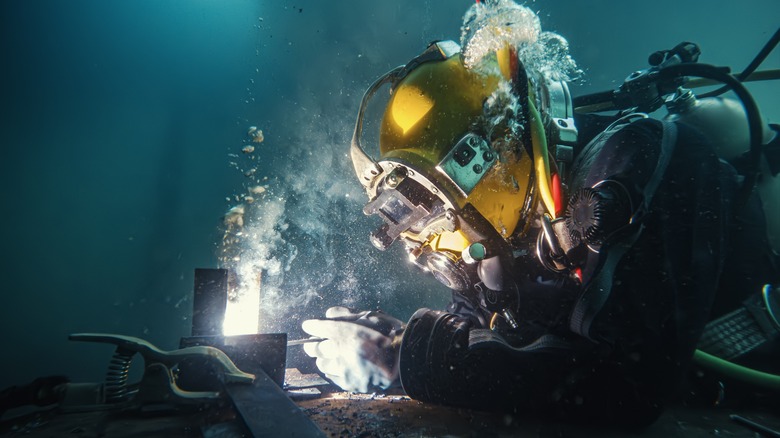Disturbing Details Found In The Byford Dolphin Accident Autopsies
Warning: The following article contains graphic descriptions of death.
The 2023 Titan submersible disaster reminded the public of the dangers of oceanic diving and deep sea work. No, humans aren't meant to go very far above or below sea level — in the former dying from a lack of oxygen and in the latter from the crushing pressure of the ocean above. Few cases illustrate this better than the Byford Dolphin incident, a horrific 1983 accident involving sudden underwater decompression that quite literally left one saturation diver in tatters and another three boiled from the inside.
The Byford Dolphin incident demonstrates exactly how little margin for error there is in the world's most lethal profession: saturation diving. Saturation divers get paid a lot, live isolated in deep underwater quarters that Atlas Obscura describes as the size of "a booth at Applebee's," and face a certain, gruesome death if they make the slightest mistake. They can also get "the bends" — aka decompression sickness — if they come to the surface too quickly. If this happens, the liquid in their body acts like the contents of a soda can through which nitrogen bubbles race and burst.
This is exactly what happened in 1983 when a diving bell from the Byford Dolphin oil rig suddenly disconnected from an underwater compression chamber. The pressure in the room dropped from 9 atm (nine times normal atmospheric pressure) to 1 atm. The Science Times says that three divers in the compression chamber "boiled from the inside," and one got shredded as he passed through a tiny hole. The men's autopsies reveal numerous disturbing details.
Diver 4 blew into pieces
A 1988 article in The American Journal of Forensic Medicine and Pathology outlines the Byford Dolphin autopsies. But really, proceed with caution, because it contains pictures of the victims' bodies and the pieces of one diver — diver 4 — who was closest to the diving bell's door when the chamber suddenly depressurized.
Diver 4 might have undergone the most gruesome fate, but thankfully didn't feel anything or even know what happened. One of the diving bell's two tenders — a person who positions it from the outside — opened one of the clamps on the chamber's door for some unknown reason, and diver 4 blasted through a 23-inch opening and "completely disintegrated." There was such an enormous pressure difference between the inside and outside of the bell that some of the remains shot up out of the water almost 32 feet and landed on the deck of the ship above.
This victim was shipped for examination in four plastic bags. His brain was missing, and his remaining organs had blown out from his torso along with his spine and ribs, leaving a hollow "empty sack" where everything used to be. Not every piece was found because some of him simply blew out into the ocean and vanished. The assembled, remaining pieces hardly resembled a person at all.
Divers 1 through 3 boiled from the inside
As the 1988 article in The American Journal of Forensic Medicine and Pathology describes, divers 1 through 3 suffered a less horrific fate than diver 4 — as far as these things go. The article contains photos of the men's bodies, which are whole and not fragmented, and blackened along certain patches of the skin. Doubtlessly this is because the men's blood "flash boil[ed]," as IFLScience says, meaning that it heated so fast that it disintegrated.
Divers 1 through 3 were unusually stiff when examined, their tissue riddled with hemorrhages and their lungs with fluid. There was a strange amount of fat in the heart that seems to have been left behind as the blood boiled. This tissue had mixed with gas bubbles and looked like "sizzling butter on a frying pan." The divers' brains were strangely pale and filled with more gas, same as their spinal columns. The eyes of diver 1 also showed evidence of subconjunctival bulla, i.e. damage from swelling. As a side note, the BBC says that it's possible for the eyes and bile in the liver and gallbladder to boil along with the blood in cases of extreme depressurization, but that doesn't seem to have happened in this case.
Ultimately, it's good that the victims of the Byford Dolphin incident died instantly, no matter how freakish the manner of death. As the BBC says, such individuals were "guinea pigs" for a new type of untested profession that started in the 1970s. The job remains dangerous to this day.


